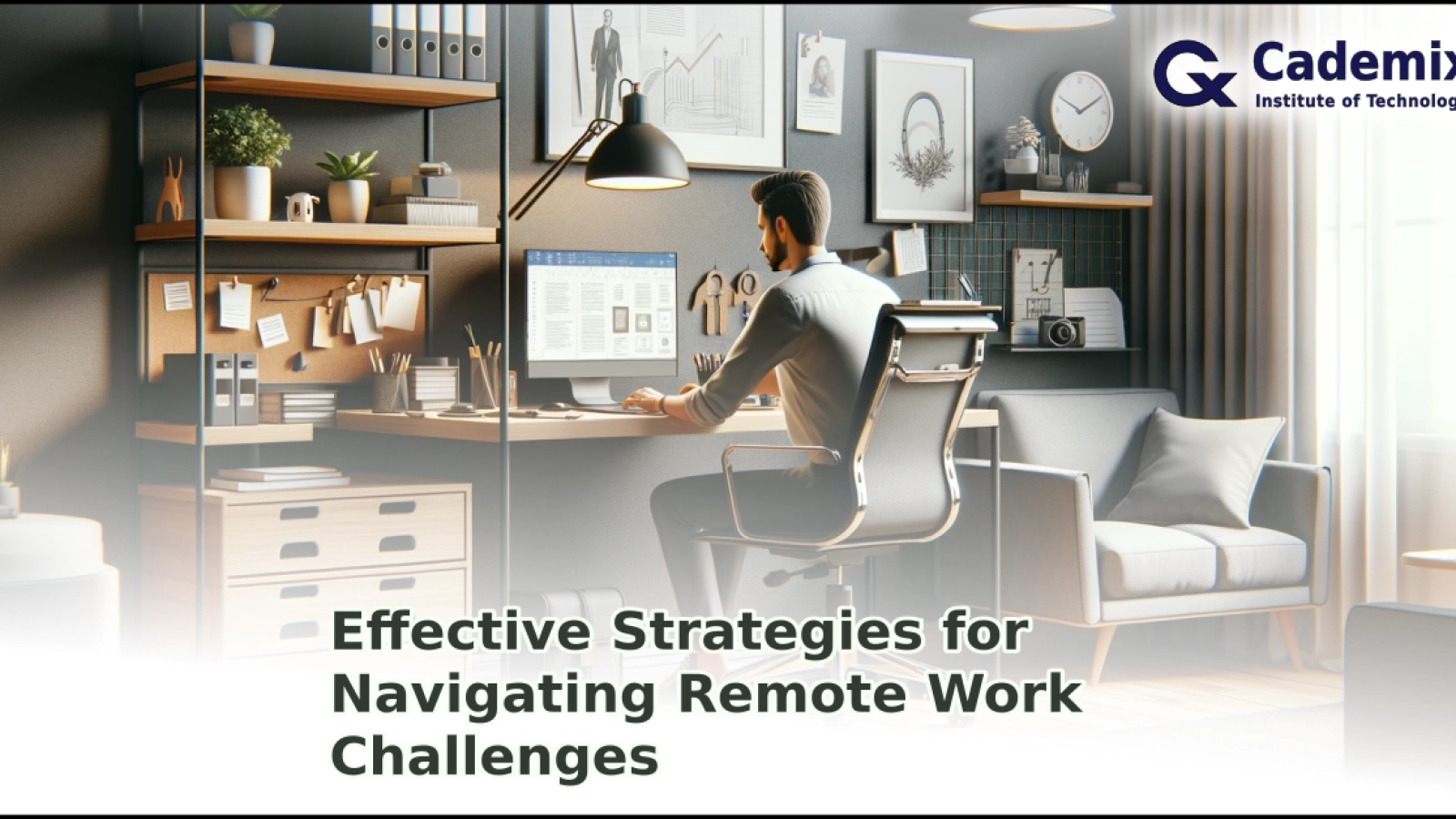In the evolving landscape of work, remote work has become a significant aspect. This article delves into effective strategies for navigating the unique challenges associated with remote work, offering insights into creating a productive and balanced work-from-home life.
Cademix Editorial Board
Designing an Effective Home Office
Creating a Conducive Work Environment
The foundation of successful remote work lies in creating an effective home office. This subsection delves into the essentials of setting up a conducive work environment at home. It covers the importance of having a dedicated workspace, ergonomic furniture, and the right technology. Tips on optimizing your home office for productivity, such as proper lighting and minimizing distractions, are also discussed.
Ergonomics and Physical Well-Being
Maintaining physical well-being while working remotely is crucial. This subsection explores ergonomic practices for setting up your home office. It includes advice on selecting ergonomic chairs and desks, positioning your computer to reduce strain, and incorporating regular movement into your workday. The focus is on creating an environment that supports physical health and prevents common issues like back pain and eye strain.

Mastering Time Management and Productivity
Establishing a Routine and Setting Boundaries
Effective time management is key to remote work success. This subsection discusses the importance of establishing a structured daily routine and setting clear boundaries between work and personal life. It offers strategies for scheduling your day, including setting specific work hours, planning breaks, and using time management tools. The aim is to provide guidance on how to stay organized and maintain a healthy work-life balance.
Overcoming Procrastination and Staying Motivated
Staying motivated and avoiding procrastination are common challenges in remote work. This subsection provides insights into understanding the root causes of procrastination and offers practical tips for staying focused and motivated. It covers techniques such as the Pomodoro Technique, goal setting, and creating a motivating work environment. Additionally, it discusses the importance of self-discipline and maintaining a positive mindset in remote work settings.
Enhancing Virtual Communication and Collaboration
Building Strong Connections with Remote Teams
In a remote work setting, effective virtual communication is vital for team cohesion and productivity. This subsection explores strategies for building strong connections with remote teams. It covers the importance of regular and clear communication, using the right digital tools for collaboration, and fostering a sense of team unity despite physical distance. Tips on organizing effective virtual meetings, team-building activities, and maintaining an inclusive team culture are also included.
Managing and Participating in Online Meetings Effectively
Online meetings are a staple of remote work. This subsection provides guidance on both managing and participating in these meetings effectively. It discusses best practices for conducting productive online meetings, including setting clear agendas, ensuring participant engagement, and using features of virtual meeting platforms efficiently. It also covers etiquette for participating in online meetings, such as being punctual, staying engaged, and following virtual meeting norms.
Balancing Work and Personal Life
Setting Boundaries for Work-Life Balance
Balancing work and personal life is a critical aspect of remote work. This subsection addresses the challenges of setting boundaries and provides practical tips for maintaining a healthy work-life balance. It covers techniques like having clear start and end times for work, creating physical separation between work and living spaces, and the importance of unplugging after work hours. The focus is on strategies that help delineate work responsibilities from personal time, ensuring overall well-being.
Managing Stress and Prioritizing Mental Health
Remote work can sometimes lead to increased stress and challenges to mental health. This subsection delves into ways to manage stress and prioritize mental health while working remotely. It includes tips on recognizing signs of stress, creating routines for relaxation and self-care, and seeking support when needed. The importance of regular physical activity, maintaining social connections, and practicing mindfulness are emphasized as key components in managing mental health in a remote work environment.
Leveraging Technology and Remote Work Tools
Selecting and Utilizing the Right Digital Tools
The right technology is a cornerstone of effective remote work. This subsection focuses on selecting and utilizing digital tools that enhance productivity and collaboration in a remote setting. It covers a range of tools, from communication platforms like Slack and Zoom to project management software like Asana and Trello. Best practices for choosing tools that fit your team’s needs and integrating them effectively into your work processes are discussed, highlighting how technology can streamline workflows and facilitate remote collaboration.
Ensuring Security and Privacy in a Digital Workspace
In the remote work environment, security and privacy become paramount. This subsection addresses the importance of safeguarding sensitive information and maintaining digital privacy. It provides guidance on secure communication practices, data encryption, the use of VPNs, and regular software updates. Tips on creating strong passwords, avoiding phishing attacks, and ensuring overall cybersecurity are included, emphasizing the role of each remote worker in maintaining the security of their digital workspace.
Developing and Maintaining a Remote Work Culture
Fostering a Positive and Inclusive Remote Work Environment
Creating a positive remote work culture is essential for team morale and productivity. This subsection explores ways to foster an inclusive and supportive remote work environment. It includes strategies for building a culture of trust and transparency, encouraging open communication, and recognizing and celebrating team achievements. The importance of regular check-ins, providing feedback, and creating opportunities for social interaction and team bonding, even virtually, are highlighted.
Navigating Challenges and Creating Opportunities for Growth
Remote work presents unique challenges but also opportunities for growth and innovation. This subsection delves into navigating the challenges of remote work, such as feelings of isolation and the difficulties of remote collaboration. It also discusses how these challenges can be transformed into opportunities for developing new skills, experimenting with new ways of working, and fostering personal and professional growth. Emphasis is placed on the importance of adaptability, continuous learning, and embracing change in the remote work landscape.
Continuous Learning and Skill Development in Remote Work
Embracing Opportunities for Professional Growth
Remote work environments offer unique opportunities for professional growth and skill development. This subsection discusses how remote workers can proactively seek out and embrace these opportunities. It covers the importance of continuous learning, strategies for acquiring new skills relevant to remote work, and leveraging online learning platforms and resources. The emphasis is on maintaining a growth mindset and staying adaptable to the evolving demands of remote work scenarios.
Utilizing Remote Work for Career Advancement
Remote work can be a powerful tool for career advancement when leveraged effectively. This subsection explores strategies for using remote work experiences to propel your career forward. It includes tips on showcasing remote work skills in your professional portfolio, networking remotely, and demonstrating your ability to work independently and efficiently to potential employers or within your current organization. The focus is on how remote work can enhance your career prospects and open doors to new opportunities.
Conclusion: Integrating Remote Work Into a Successful Career Journey
Summarizing Strategies for Effective Remote Work
The conclusion of the article aims to integrate and summarize the key strategies and insights discussed throughout. It highlights the significance of creating an effective home office, mastering time management, enhancing virtual communication, balancing work and personal life, and leveraging technology. The section reinforces the importance of adapting to remote work challenges and viewing them as opportunities for personal and professional growth.
Looking Ahead: The Future of Remote Work
The article looks ahead to the future of remote work, contemplating its evolving role in the professional landscape. It discusses the potential long-term impacts of remote work on career trajectories, workplace dynamics, and the global job market. The focus is on encouraging readers to stay informed, adaptable, and proactive in navigating their remote work journey as part of their overall career success.
References and Further Reading
To aid in further exploration and deeper understanding, this final section provides a list of references and recommended reading materials. These resources include books, articles, online courses, and webinars, offering additional insights into remote work strategies, digital collaboration, work-life balance, and the future of work in a remote setting.

